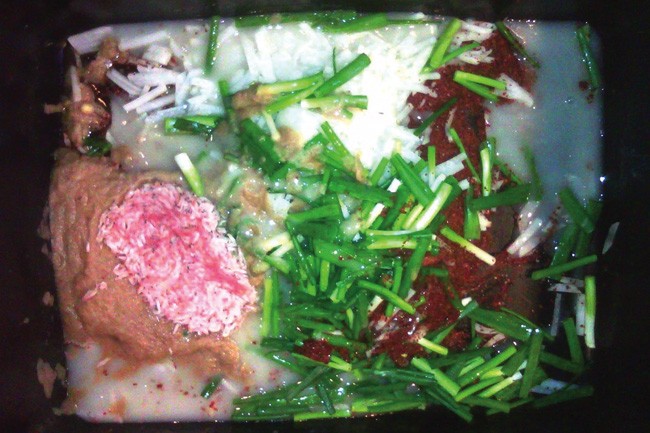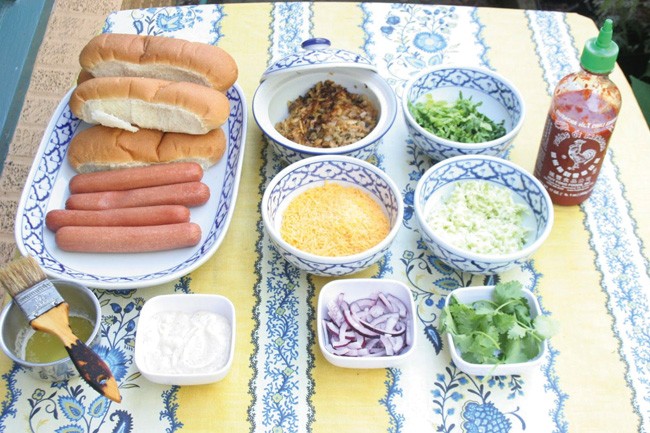It’s smelly, spicy, scary-looking and quite possibly the world’s healthiest food. It hisses and foams when you open its jar. It is revered by Koreans and reviled by many Americans. Kimchi – you either love it or hate it.
I’ve long been a lover of kimchi, though in my early days it was a social liability. There were few others for me to share my enthusiasm with. Nothing would clear a room faster than opening a jar of kimchi. Now kimchi has penetrated American pop culture and is showing up in Korean tacos on menus of chain restaurants such as TGI Fridays. Kimchi has been popularized as one of the world’s healthiest foods. It is rich in vitamins A and C and beneficial gut-boosting lactobacillus bacteria. And many say that it’s excellent for your immune system, thanks to both the bacteria and the chili peppers.
Kimchi is a fermented Korean vegetable pickle, similar to sauerkraut. Traditional kimchi is made from cabbage, garlic, red pepper and salt, but can also be made from cucumber, radishes, leeks, scallions or chives. Typically the vegetables are salted, drained, then mixed with a spicy pepper paste and allowed to ferment. In Korea, raw kimchi is served on a daily basis as a side dish. Kimchi is salty, spicy, garlicky, funky and just a touch sweet. It’s strange, foreign and, to some, off-putting.
My entrée into the world of kimchi was from a jar purchased at the grocery store. It tasted like sauerkraut with hot sauce. It had that funky, hard-to-define umami thing going. Later in life I discovered the Korean superstore H Mart in the Chicago suburb of Niles, where I was able to watch fresh kimchi being made by smiling Korean grandmothers. Working in large plastic tubs, fiery pepper paste was gently massaged between the leaves of whole Napa cabbages, and then portioned into quart plastic bags. This was my first homemade kimchi. Its taste changed daily as it fermented. It was spicy-sweet initially. As it aged, the sweetness became more caramel-like, and then acidic with a bit of effervescence.
One fall I came across the most beautiful Napa cabbage at the Old Capitol Farmers Market. I decided to buy a bushel and attempt to make my own kimchi (recipe follows). Sourcing ethnic ingredients can often be a challenge, but I was able to find Gochugaru (Korean red chili pepper powder), fish sauce and tiny salted shrimp at the local Asian food store. The other ingredients (daikon radish, garlic, green onions and ginger) were easily obtainable from the grocery store produce department. I made 20 quarts that fall, more than I could consume or give away. The refrigerator in my basement will smell like kimchi forevermore.
As kimchi ages and ferments, its taste becomes stronger and less appealing to eat raw. At this stage it can be incorporated into dishes such as stews, soups, fried rice and savory pancakes. Older kimchi undergoes a marvelous transformation when sautéed in butter. Its flavors sweeten and soften as it caramelizes. I use sautéed kimchi as a hot dog condiment in my version of the Kogi Dog. Kogi Dogs are Korean-style hot dogs made popular by Los Angeles chef Roy Choi and his iconic Kogi food truck. Choi is a classically trained Korean American chef who was named one of the top ten “Best New Chefs” of 2010 by Food & Wine magazine, and was the first food truck operator to win that distinction.
Basic Napa kimchi
- 1 head Napa cabbage, about 2 pounds
- 1/3 cup coarse salt
- 1 cup peeled and julienned daikon radish
- 1 tablespoon or more of Gochugaru (ground red Korean chili powder)
- ¼ cup fish sauce
- 2 tablespoons minced garlic
- 1 tablespoon peeled and minced ginger
- 2 tablespoons sugar
- ½ cup finely chopped scallions, green part only
- 3 tablespoons salted shrimp (sold in jars in refrigerated case in Asian stores)
Place the cabbage in a colander and sprinkle it with the salt, making sure to get plenty of salt between the layers of leaves. Let sit, undisturbed, for 2 to 3 hours.
When the cabbage is very wilted, rinse it well, making sure to rinse again between the layers of leaves. Shake it dry.
Mix together radish, ground chilies, fish sauce, garlic, ginger, sugar and scallions; the mixture will be bright red.
Combine salted shrimp with spice mixture.
Use your fingers to pack the whole cabbage, inside and out, with the mixture. Or cut the cabbage up, and toss it with the mixture. Serve immediately, whole or cut, or refrigerate. It will become spicier every day.
Kogi Dogs
- 2 cups finely shredded cabbage
- 1 large scallion, finely chopped
- 1 tablespoon fresh lime juice
- Salt and freshly ground pepper
- 1 tablespoon toasted sesame seeds
- 1/2 cup mayonnaise
- 2 tablespoons butter
- 1 cup kimchi, drained and patted dry
- 8 hot dog buns, split
- 8 all-beef hot dogs
- 1 cup shredded sharp cheddar
- 2 cups romaine, julienned
- 1 small red onion, thinly sliced
- Cilantro sprigs
- Sriracha
Combine the cabbage, scallions and lime juice; season with salt and pepper.
In a mortar, pound the sesame seeds until crushed and transfer to a small bowl. Stir in the mayonnaise and season with salt.
In a nonstick skillet, heat 1 tablespoon of butter. Add the kimchi and cook over medium-low heat until caramelized, about 10 minutes.
Light a grill. Brush the insides of the buns with melted butter and grill until lightly toasted. Spread the cut sides with the sesame mayonnaise.
Grill the hot dogs until nicely charred all over, about 5-8 minutes. Tuck the hot dogs into the buns with the kimchi and cheddar. Top with the cabbage salad, romaine, onion and cilantro sprigs. Top with a little sriracha and serve.
Peter Glatz agrees with food activist Michael Pollan who wrote that fermenting your own food is a “declaration of independence from an economy that would much prefer we remain passive consumers of its standardized commodities, rather than creators of idiosyncratic products expressive of ourselves and of the places where we live, because your pale ale or sourdough bread or kimchi is going to taste nothing like mine or anyone else’s.”




















